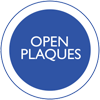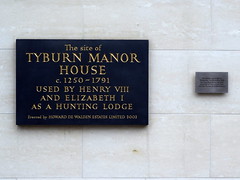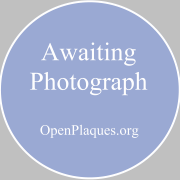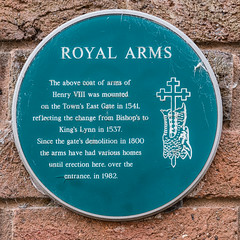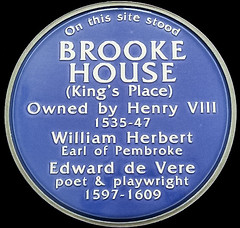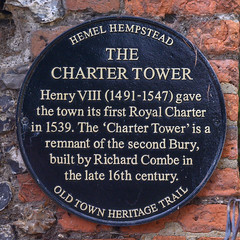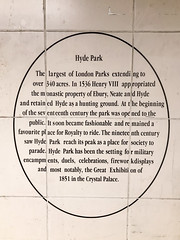King Henry VIII of England


King Henry VIII of England
(1491-1547)
Duke of Cornwall (1502-1509), Prince of Wales (1502-1509), and King of England (1509-1547)
Family tree
-
King Henry VII of England (1457-1509) King of England
Elizabeth of York (1466-1503)
- King Henry VIII of England (1491-1547) Queen Catherine of Aragon (1485-1536) Queen Consort of England Queen Anne Boleyn (1501-1536) Queen Consort of England Queen Jane Seymour (1508-1537) Queen Consort of England Queen Anne of Cleeves (1515-1557) Queen Consort of England Queen Catherine Howard (1523-1542) Queen Consort of England Queen Catherine Parr (1512-1548) Queen Consort of England
- Queen Margaret Tudor of Scotland (1489-1541) Queen of Scotland
- Arthur Tudor (1486-1502) Duke of Cornwall
- Mary Tudor (1496-1533) Queen Consort of France
Commemorated on 13 plaques
Here stood the Palace of Bridewell built by Henry VIII in 1523 and granted by Edward VI in 1553 to the City of London to house Bridewell Royal Hospital founded by Royal Charter in the same year. The present building was erected in 1802 and in 1862 the court room of the Bridewell Royal Hospital was incorporated therein
14 New Bridge Street, London, United Kingdom where they built
The site of Tyburn Manor House c. 1250 - 1791 Used by Henry VIII and Elizabeth I as a hunting lodge
Marylebone High Street, London, United Kingdom where they used as a hunting lodge
Brooke House (King’s Place) Stood on this site From late 15th century - 1955. Owned by Henry VIII, 1535-47. Fulke Greville (Lord Brooke) Poet and courtier lived here 1609-1628.
Brooke House Sixth Form College, Kenninghall Road, Hackney, London, United Kingdom where they owned
The King's Manor. A house was built on this site c.1270 as a Residence for the Abbot of St. Mary's Abbey but was substantially rebuilt in the late 15th century. After the Dissolution of the Monasteries in 1539 it became, until 1641, the Headquarters of the Council of the North and the Residence of its Presidents who added to the buildings. Henry VIII, Charles I and James I stayed there. Since 1963 it has been occupied by the University of York.
Exhibition Square, York, United Kingdom where they stayed
Royal Arms The above coat of arms of Henry VIII was mounted on the Town's East Gate in 1541, reflecting the change from Bishop's to King's Lynn in 1537. Since the gate's demolition in 1800 the arms have had various homes until erection here, over the entrance, in 1982.
College Lane, King's Lynn, United Kingdom where they was
King Henry VIII 1491-1547 Close to this site stood the King's Manor House. Part of its boundary wall adjoins Cheyne Studio
23 Cheyne Walk, Chelsea, SW3, London, United Kingdom where they lived near
Original features of the Red Lion Inn dating back to the 15th Century are revealed inside. Both Henry V & Henry VIII are believed to have stayed here.
Red Lion Inn, High Street, Sittingbourne, United Kingdom where they stayed
King Henry VIII’s Manor House stood here until 1753 when it was demolished after the death of its last occupant, Sir Hans Sloane. Nos. 19 to 26 Cheyne Walk were built on its site in 1759-65. The old manor house garden still lies beyond the end wall of Cheyne Mews and contains some mulberry trees said to have been planted by Queen Elizabeth I.
23 Cheyne Walk, Chelsea, SW3, London, United Kingdom where they lived
York Gate About the time of Henry VIII a small wooden pier appears to have been built here. For the safety of the fishing craft, probably by the Coleman family, who fortified the gate or way leading down to the seashore by the arched portal. Defended by a portcullis and strong gates, to prevent the inhabitants from being plundered by the sudden incursions of privateers. These gates have for many years been gone, and as the stonework was fast decaying, it was repaired and beautified by Lord Henniker. When Sir John Henniker, above the arch is the following inscription. York Gate July 17 1811
Harbour Street, Broadstairs, United Kingdom where they was
On this site stood Brooke House (King's Place) Owned by Henry VIII 1535-47 William Herbert Earl of Pembroke Edward de Vere poet & playwright 1597-1609
BSix Sixth Form College, Kenninghall Road, Lower Clapton, Hackney, London, United Kingdom where they was
The Charter Tower Henry VIII (1491-1547) gave the town its first Royal Charter in 1539. The 'charter Tower' is a remnant of the second Bury, built by Richard Combe in the late 16th century.
Queensway, Hemel Hempstead, United Kingdom where they was
St John Street Until 1840 and the creation of Priory Road, the main entry to Wells from Glastonbury was via Southover and St John Street, named after the Priory of the Hospital of St John the Baptist, founded c1220 by Bishop Jocelyn and his brother Bishop Hugh of Lincoln. The Priory was a religious community dedicated to worship, nursing the sick, and helping the poor and the disabled. It comprised the Prior and ten Brothers. The Priory was dissolved by Henry VIII in 1539, but the main Priory buildings survived until 1859, being then demolished and replaced by the Central School, whose buildings still exist but are now converted into dwellings. The adjacent house, called The Priory, was probably the Prior's lodging, and contains significant mediaeval remains.
1 Priory Road, Wells, United Kingdom where they was
Hyde Park The largest of London Parks extending to over 340 acres. In 1536 Henry VIII appropriated the monastic property of Ebury, Neate and Hyde and retained Hyde as a hunting ground. At the beginning of the seventeenth century the park was opened to the public. It soon became fashionable and remained a favourite place for Royalty to ride. The nineteenth century saw Hyde Park reach its peak as a place for society to parade. Hyde Park has been the setting for military encampments, duels, celebrations, firework displays and most notably, the Great Exhibition of 1851 in the Crystal Palace.
Hyde Park Corner, London, United Kingdom where they was
